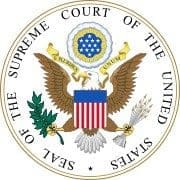
Oct 12, 2021 | Supreme Court
The Tennessee Supreme Court released an opinion, Tennessee v. Kevin Anthony Dickson, earlier this week that affirmed the attempted murder conviction for one East Tennessean, Kevin Anthony Dickson. Dickson was found guilty after one of his accomplices shot two individuals who were connected with a drug dealer that had sold Dickson poor quality cocaine.
According to the recently released opinion, the trouble began when Dickson purchased cocaine from a drug dealer in Gatlinburg and was then upset over the quality of the drug he received. According to the Court, Dickson procured weapons and ammunition and enlisted two friends to help him confront the drug dealer who sold him the bad coke and extract a refund. The group gathered their weapons, with Dickson only carrying a set of brass knuckles and a metal baton, ultimately forcing their way into the drug dealer’s home.
After entering the cabin where the drug dealer was staying, one of Dickson’s accomplices, whom Dickson had given a .45 pistol, shot and seriously wounded two unarmed victims with no connection to the drugs. Dickson and others then went on to beat several other guests in the cabin with the metal bat and other instruments. Thankfully everyone survived the attack, though one of those who were shot was left partially paralyzed.
Dickson and his friends were arrested and ultimately taken to trial where the judge ruled that Dickson was criminally responsible for the actions taken by the shooter. Given his close association with the shooter, Dickson was found guilty of two counts of attempted first-degree murder and one count of aggravated burglary, attempted aggravated robbery and aggravated assault. Dickson was sentenced to consecutive 25-year sentences for each attempted murder conviction.
Dickson appealed his case to the Tennessee Court of Criminal Appeals which ultimately reduced one of the counts down to attempted second-degree murder, finding that there was not enough evidence of premeditation with respect to the shooting of the first victim who was shot almost immediately upon entering the house. The case was then appealed up to the Supreme Court, which considered whether there was sufficient evidence to justify the two convictions for attempted first-degree murder.
Unfortunately for Dickson, the Supreme Court decided that that the lower court was right to convict him of two counts of attempted first degree murder and also that the consecutive 25-year sentences were proper.
The Supreme Court said that Dickson could be criminally responsible for the actions of his co-defendant because he acted with intent to promote the commission of the offense. The Court also found that Dickson’s co-defendant acted with premeditation when he fired upon his victims. This was shown by the co-defendant agreeing to take a loaded pistol into the cabin, something that a reasonable person could determine showed planning on the part of the shooter to use the deadly weapon on those located in the cabin. The Court said the co-defendant had formed the intent to commit the act before ever entering the house, which is why the attempted first-degree murder charge for the first victim ought to be reinstated.
Oct 11, 2021 | News
Davis & Hoss attorney Janie Varnell featured in the Herald.

Oct 9, 2021 | Supreme Court
An issue before the U.S. Supreme Court involves the late appearance of evidence that may demonstrate a criminal defendant’s innocence. Though many people assume that if evidence were to arise showing that someone was clearly innocent of the crime they were accused of committing, no matter how late, then it would be considered by the court. Perhaps it may come as a surprise to some, this is not always the case. Here is the petition for certiorari granted by the Supreme Court on this issue filed by Floyd Perkins.
The actual issue presented states: The Antiterrorism and Effective Death Penalty Act of 1996 (AEDPA) contains a one-year statute of limitations for filing a habeas petition. In Holland v. Florida, 130 S. Ct. 2549, 2562 (2010), the Supreme Court affirmed that a habeas petitioner is entitled to equitable tolling of that one-year period “only if he shows: (1) that he has been pursuing his rights diligently, and (2) that some extraordinary circumstance stood in his way and prevented timely filing.
Floyd Perkins’ petition presents two recurring questions of jurisprudential significance involving equitable tolling under AEDPA that have divided the circuits:
1. Whether there is an actual-innocence exception to the requirement that a petitioner show an extraordinary circumstance that “prevented timely filing” of a habeas petition.
2. If so, whether there is an additional actual- innocence exception to the requirement that a petitioner demonstrate that “he has been pursuing his rights diligently.
As Justice Antonin Scalia wrote in 2009, the Supreme Court has never held that “the Constitution forbids the execution of a convicted defendant who had a full and fair trial but is later able to convince a habeas court that he is ‘actually’ innocent.”
The Supreme Court now has agreed to hear a case that demonstrates exactly why the issue can be a tricky one. The case involves a Michigan man, Floyd Perkins, who is serving a life sentence for murder. New evidence was uncovered and a long time passed before it was presented. The issue now is whether it can be raised or whether Perkins should spend the rest of his life in prison for a crime he says he did not commit.
The details of the incident begin with a house party in 1993. Perkins was in attendance and left with two other men, one of whom was later found dead in the woods, having been stabbed in the head. The third man, Jones, testified that Perkins murdered him. Perkins said he parted ways with the other two and later ran across his accuser under a streetlight covered in blood. The jury ultimately believed the accuser, voting to convict Perkins.
After his conviction Perkins worked to collect evidence demonstrating his innocence. There was an affidavit from his sister that said she heard secondhand that Jones had bragged about the killing and had taken bloody clothes to a drycleaner. This is hearsay and it is from a relative, both facts undermined the value of the testimony. A few years later Perkins got a second sworn statement from an acquaintance of Jones’ who said Jones confessed to the killing and confirmed the story about the dry cleaning. Then, a few years after that an employee of the dry cleaning store said that a man who looked like Jones had indeed come in to drop off bloody pants to be cleaned.
Finally, with this information gathered, Perkins asked a federal court to throw out his conviction in 2008. Magistrate Judge Timothy P. Greeley of the Federal District Court in Marquette, Michigan recommended that his request be denied because it was filed too late. Perkins appealed but to no avail. Then the Sixth Circuit Court of Appeals reversed the ruling. It ordered Judge Bell of the Federal District Court in Grand Rapids to consider whether the new evidence was credible enough to justify consideration.
After the Sixth Circuit decision, Michigan appealed to the Supreme Court, and with the support of 10 other states, argued that deadlines are important procedural rules and ought to be enforced as written. They say the legal requirement is that such claims be pursued diligently.
However, Perkins argues that’s exactly what he did. He filed a note with the lower court before the deadline passed explaining that many of his documents and property had been destroyed by prison personnel following a skirmish. He was subsequently denied access to the law library and placed in solitary confinement for nearly five years, making further work on his case all but impossible.
Though the evidence is suggestive, it’s not factually conclusive for Perkins. Had it been presented at trial it may have made a difference, or maybe not. The question is whether there is enough reason to justify Perkins presenting it to a court for consideration now.
Oct 7, 2021 | Sixth Circuit
UNITED STATES v. HERBERT WILFRED NIXON
The 6th U.S. Circuit Court of Appeals recently decided to uphold the five-year sentence of a man who sent threatening letters to a federal judge in Nashville – including one that contained a white powdery substance which was later found to be a harmless artificial sweetener.
Herbert Wilfred Nixon sent the letters to Senior Judge Thomas Wiseman in 2002 after Wiseman sentenced him to three years in prison for credit card fraud. “The unsigned letters demanded money and threatened the judge’s life,” according to the 6th Circuit opinion written by Judge Raymond M. Kethledge.
Nixon pleaded guilty to making a false threat involving a biological weapon, in violation of 18 U.S.C. § 1038(a)(1).. While federal sentencing guidelines only called for a sentence of 30 to 37 months, U.S. District Judge William J. Haynes Jr. decided to send a strong message and sentenced Nixon to 60 months, the statutory maximum. Judge Haynes also ordered that Nixon have no contact with any member of the postal service during his three years of supervised release.
Nixon argued that the sentence was unreasonable. However, the three-judge appellate panel upheld it, citing factors including Nixon’s criminal history and the fact that his hoax “required the government to spend resources responding to a bio-hazard threat and were meant to terrorize a district judge and his staff.”
The Court wrote that just because another appellate court might have imposed a different sentence does not mean reversal is appropriate. The Court found that given the circumstances of Nixon’s offense, his criminal history, and his refusal to be deterred by a prior 36-month sentence, the district court’s sentence of 60 months was not an abuse of discretion.
Nixon also challenged the supervised release condition barring him from contact with any member of the postal service. The Court disagreed again, saying that Nixon used the postal service to commit his crimes, so the supervised release condition was reasonably related to the nature and circumstances of his offense and thus reasonable. The panel found that condition was even more palatable given that Nixon was only prohibited from contacting members of the postal service; he was not barred from using the service altogether.
For the full opinion, click here.

Oct 7, 2021 | Business Law
The major cell phone providers, including AT&T, Verizon and Sprint, may be required to keep information about their customers’ text messages for at least two years according to a proposal that various law enforcement agencies submitted to Congress.
A group of different police organizations asked legislators to require wireless companies to retain information, warning that a lack of federal requirements leaves a major hole in the ability of law enforcement agencies to launch proper investigations. The move was designed to include text message retention in an upcoming overhaul of the 1986 Electronic Communications Privacy Act, a privacy law meant to reflect the new realities of the modern technological era.
As text message usage has exploded recently so have the instances of their use in criminal investigations. They have been used as evidence in robberies, drug dealing and financial fraud cases. One great example occurred in 2009 when SkyTel turned over a whopping 626,638 text messages in Michigan.
Currently, the approaches used by the various companies are all over the place. Verizon and some others retain their text messages only for a brief period of time. Others, including T-Mobile do not store the messages at all. A Justice Department document obtained by the ACLU found that in 2010, AT&T, T-Mobile, and Sprint did not store the contents of text messages. Verizon did for up to five days, a change from its earlier no-logs-at-all position, and Virgin Mobile kept them for 90 days. The carriers generally kept data like the phone numbers associated with the text for 90 days to 18 months; AT&T was an outlier, keeping it for as long as seven years, according to the chart.
The groups making the request include the Major Cities Chiefs Police Association, the National District Attorneys’ Association and the National Sheriffs’ Association. It has not yet been made clear by the groups whether they want the telecommunications companies to store the content of the text messages or only to hold on to data including the numbers used to send and receive the messages. No matter which approach is employed it will be a massive responsibility for the cell phone providers with some 2 trillion text messages sent in the U.S. last year, coming out to nearly 6 billion per day.
The problem with the request for retaining the text messages is that there is ultimately only one reason for companies to do such a thing: to keep databases of information on their customers so police officers can fish for evidence at their leisure.
Source: “Cops to Congress: We need logs of Americans’ text messages,” by Declan McCullagh, published at CNET.com.



